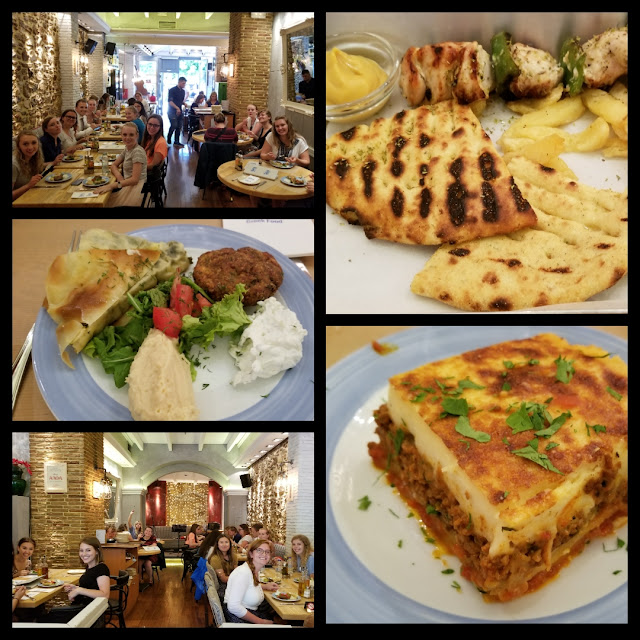 |
| Standing in front of the Areiopagos (Mars Hill) this morning in the falling rain. |
One of the hashtags that I used on all but about two of my social media posts today was #rainyathens.
The cloudburst that we had on the Filoppapos Hill at the end of our orientation walk Friday did not turn out to be the last rain that we saw. After hot, pretty clear weather for most of the day yesterday, another rainstorm hit in the evening just as most of us were walking around Athens for free time. Then, despite my hopes, I woke to find it raining this morning for our only full day in the city.
I can hardly tell you how unusual this is. Like many countries bordering the eastern coasts of the Mediterranean Sea, Greece receives most of its rain in the winter months and early spring. It was a bit rainy in the northern part of the country when I was here with my Alcuin Fellowship in 2010, but I have never known it to rain much when I have been in Athens during the summer. So far, it has rained every day we have been here.
While this slowed us up some, it did not stop us. We were able to do almost everything we had planned, though some of the extra time it took us to get around and a surprise change of time for sacrament meeting did mean that we ended up missing our appointment for the National Archeological Museum this afternoon (even though that was, ironically, an indoor activity).
Morning Devotional on Mars Hill
Our plan was to start our Sabbath early with a sunrise devotional on the Areopagus, which is called "Mars Hill" in the KJV of Acts 17. This is where the apostle Paul was brought to explain his early preaching here in Athens and where he delivered his famous speech on "The Unknown God." Climbing the rock, I read from Acts 17, interlacing the passage with commentary. We then sang "I'll Go Where You Want Me To God" and prayed.
 |
| "I'm preaching in the rain, just preaching in the rain . . ." |
 |
| This dog met up with us as we emerged from the Akropoli metro station and then padded along in the rain with us all the way to the Areopagus. I though he deserved his own picture. |
The Acropolis!
 |
| Standing in the rain before the Propylaea before the students started their self-guided tour of the Acropolis. |
 |
| The small but beautiful temple of Athena Nike perches on a bastion to the side of the Propylaea. |
 |
| Yep kids, its raining |
 |
| Yes, I love this place, even in the rain. |
 |
| Ongoing restoration work cloaks the western face of the Parthenon in scaffolding, but it is still amazing. |
 |
| With Rachel in front of the eastern side of the Parthenon. |
 |
| The Erechtheion, which boasts the famous Porch of the Maidens and an interesting floor plan. |
 |
| Looking down at the Theater of Dionysus from the Acropolis. The New Acropolis Museum, which we visited later this morning, lies behind it. |
The Agora
While the Acropolis was the primary religious center of ancient Athens, the Agora, or marketplace (literally "come together place"), was the civic and commercial center of the city. Our visit here was a bit rushed as the students went through the site, seeing where ancient porticoes, honorary statues, the well-preserved Temple of Hephaestus, and the restored Stoa of Attalus are.
The New Acropolis Museum
When I first started coming to Greece, the only museum containing finds from the Acropolis was an old, low-lying building on the east end of the hill. In 2009, a spacious, modern new museum south of Acropolis was opened that contained numerous items---everything from pottery, figurines, and other small finds from the Bronze and Dark Ages to the remains of the Archaic temples destroyed by the invading Persians in 480 B.C. to the precious carvings and statues from the Classical buildings that have been moved inside for better care and preservation. Because so many of the early items have not yet been properly published, photographs can only be taken of the Classical items on the upper floors.
 |
| The actual Parthenon can be seen through the windows. |
LDS Sacrament Meeting
Yep, this week we did make it to church. Unfortunately the time posted on the internet for the English-speaking branch was not the same as when it actually met. After last week's misadventure, I was prompted to call the mission office this morning to confirm the address and time. Upside: we made church. Downside: we missed our planned visit to the National Archeological Museum. I felt bad about that, but as our guide Sophia reminded me yesterday, our groups do not know what they have missed if we do not tell them (whoops, I kind of just did).
A Few Other Sites
Note to self: there can never be enough time in Athens, so if you repeat this study abroad in a couple of years, add at least another day. After church and before dinner, however, we did visit the Hellenic Parliament (former Royal Palace) to see the famous guards, the Temple of Olympian Zeus, and the Arch of Hadrian. I am exhausted and it's late, so you'll need to click on the links to read the Wikipedia articles on them if you want to know more.
And once again, there was dinner . . .
We had another great meal, this time at the Ydria Restaurant in Plaka. Oh, and there may have been some music and dancing at the end.
























No comments:
Post a Comment